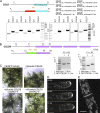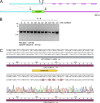Cellulose synthase-like D movement in the plasma membrane requires enzymatic activity
- PMID: 37071416
- PMCID: PMC10120407
- DOI: 10.1083/jcb.202212117
Cellulose synthase-like D movement in the plasma membrane requires enzymatic activity
Abstract
Cellulose Synthase-Like D (CSLD) proteins, important for tip growth and cell division, are known to generate β-1,4-glucan. However, whether they are propelled in the membrane as the glucan chains they produce assemble into microfibrils is unknown. To address this, we endogenously tagged all eight CSLDs in Physcomitrium patens and discovered that they all localize to the apex of tip-growing cells and to the cell plate during cytokinesis. Actin is required to target CSLD to cell tips concomitant with cell expansion, but not to cell plates, which depend on actin and CSLD for structural support. Like Cellulose Synthase (CESA), CSLD requires catalytic activity to move in the plasma membrane. We discovered that CSLD moves significantly faster, with shorter duration and less linear trajectories than CESA. In contrast to CESA, CSLD movement was insensitive to the cellulose synthesis inhibitor isoxaben, suggesting that CSLD and CESA function within different complexes possibly producing structurally distinct cellulose microfibrils.
© 2023 Wu et al.
Conflict of interest statement
Disclosures: The authors declare no competing interests exist.
Figures












References
-
- Bernal, A.J., Jensen J.K., Harholt J., Sørensen S., Moller I., Blaukopf C., Johansen B., de Lotto R., Pauly M., Scheller H.V., and Willats W.G.. 2007. Disruption of ATCSLD5 results in reduced growth, reduced xylan and homogalacturonan synthase activity and altered xylan occurrence in Arabidopsis. Plant J. 52:791–802. 10.1111/j.1365-313X.2007.03281.x - DOI - PubMed
Publication types
MeSH terms
Substances
Grants and funding
LinkOut - more resources
Full Text Sources
Research Materials
Miscellaneous

